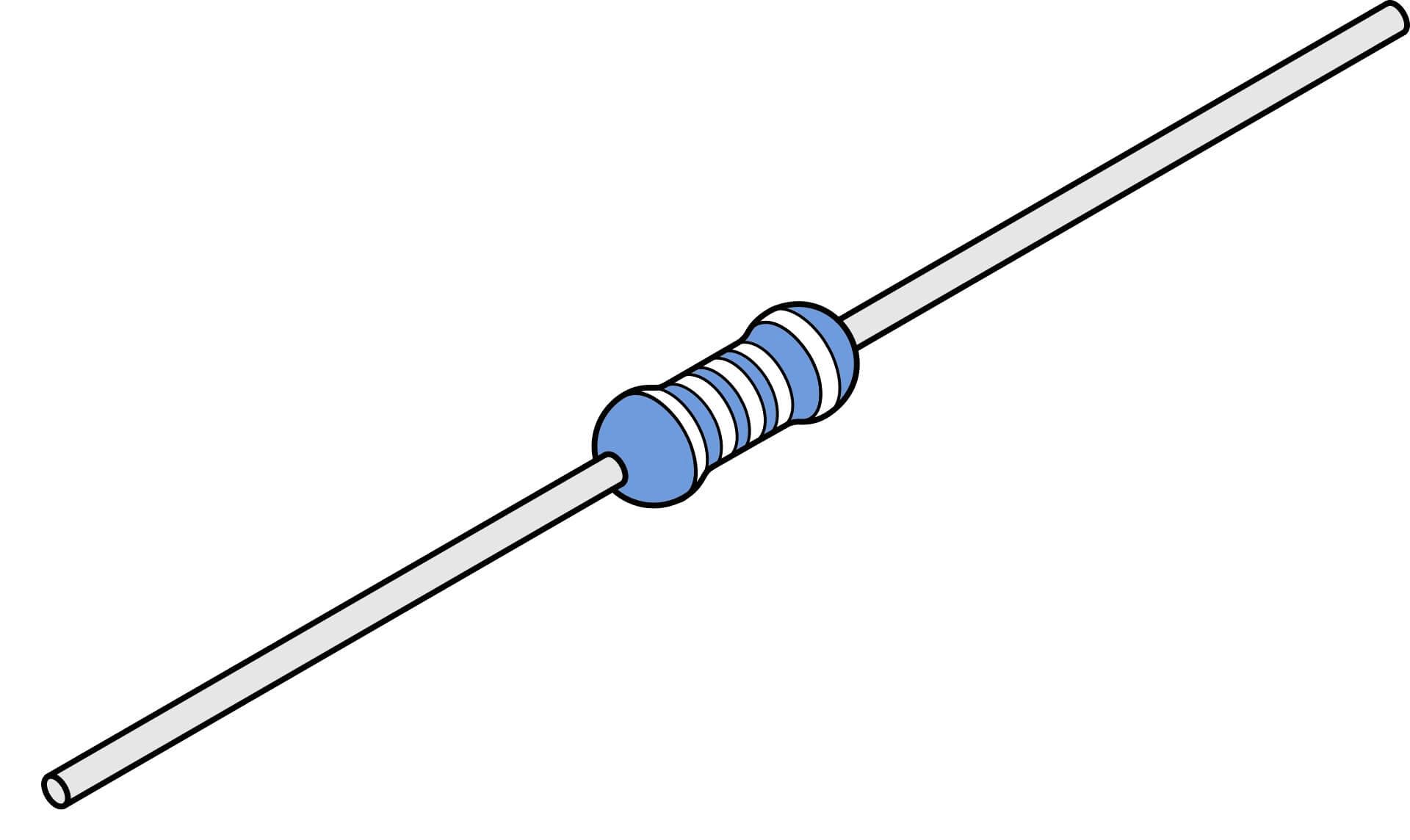In this article, we discussed the information about the resistor color code and different methods for reading the resistors values.
Overview of Resistor
A resistor limits the flow of current via an electrical device. After being connected to the circuit, the resistor’s resistance is typically fixed with two pins, which can restrict the current flowing through the branch to which it is linked.
A fixed resistor is one whose resistance cannot be altered. A potentiometer or variable resistor is a device that has changeable resistance.
The instantaneous current flowing through a linear resistor is proportional to the applied instantaneous voltage. Voltage division is accomplished using the variable resistor.
One or two moveable metal contacts are firmly pressed onto the bare resistor body. The resistance between either end of the resistor and the contact depends on where the contact is positioned.
Terminal voltage and current have a clear functional relationship. It’s a two-terminal gadget that exhibits the capacity to change electrical energy into other forms. Its symbol is the letter R, and its unit is the ohm.
Resistor elements can be expressed as actual equipment like lamps, heating wires, resistors, etc.
After reading this tutorial, if you are still unable to calculate the resistance value precisely, you can use the resistance ribbon analysis calculation tool on Electronic Platform related to electronic products to quickly determine the resistance value and tolerance of the resistor color code.
The current is constrained by resistors. When a resistor is connected to a circuit, its value is established.

Factors affect Resistance
The resistance value of a resistance element is often correlated with temperature, material, length, and cross-sectional area.
The physical quantity that measures how much resistance is impacted by temperature is known as the temperature coefficient, which is defined as the percentage of the resistance value that changes as the temperature increases by 1°C.
Resistor Applications
The ability of a resistor to transform electrical energy into thermal energy is its main physical characteristic. It can also be argued that it uses energy because it generates internal energy as current passes through it.
Resistors often divide voltage and current in a circuit. Resistors can be used to indicate both AC and DC signals.
Overview of Resistor Color Code
Typically, resistors are too small for manufacturers to put numbers and letters on them. To help people understand and distinguish different resistance values, the Radio Manufacturers Association created resistor color codes in 1920. (RMA).
To indicate the resistance value, resistors are encircled by rings or bands of different colors, each of which has a corresponding decimal number.
Resistor color coding has the essential advantage of making the color bands visible and easy to read regardless of where or how the resistor is orientated on the circuit board, even if it is somewhat dirty or severely burned out.
Typically, cylindrical resistors such as wire-wound, carbon film, metal film, and metal oxide film resistors are used with the resistor color code.
Chart of Resistor Color Code

Methods to Reading Resistor Color Code
The resistor color coding bands are used in many items, including household appliances and electronic components. The color bands can be viewed clearly and rapidly regardless of how the resistor is configured because they are used to represent colors.
Four-band color-coded resistors are the most often used type, but five-band resistors provide excellent precision.
There are also extremely expensive resistors with six bands that are only used in high-tech products.
The three fundamental units of resistance are the ohm, kiloohm, and megaohm. One kiloohm (K) is equal to one megaohm (M), and 1000 K is equal to one ohm (). (M).
It is best to read the resistor color coding as follows:
Calculating the Color Coding for Four Band Resistors
The most popular kind of resistors are those having four band color codes, often known as fourth band resistors. As indicated in the illustration, the resistance is represented by four color bands, counting the resistor color code from left to right.
The first color band depicts the resistance value’s greatest digit; the second color band, its second significant digit; the third color band, its multiplication factor; and the fourth band, its tolerance.
As an illustration, the resistor’s first band is green, representing 5, the second band is blue, representing 6, the third band is brown, representing a multiple of 10, and the fourth band is red, representing a tolerance range of 5% for the resistor. This indicates that the resistor’s resistance value is 560 2%, or 260.
Calculation of a Five-band Resistor
5-band resistors refer to a resistor with five-band color codes that feature high precision. The five color bands are used to represent the resistance value, counting the resistor color code from left to right, , as shown in figure 2.
Compared to the resistor with four color bands, it has an extra band to represent the third digit.

The first three-color bands represent the largest digit, the second digit, and the third digit of the resistor value respectively. The fourth and 5th color band indicates the multiplication factor and the tolerance respectively.
For example, the first band of the resistor is green (representing 5), the second band is blue (representing 6), the third band is orange (represent 3), the fourth band is brown (representing a multiplication of 10), and the fifth band is red (representing a tolerance range of ±5%). This means that the resistance value of the resistor is 5630±5%Ω or 5.63kΩ.
Calculation of the Six-band Resistor Color Code Chart
There are very expensive resistors with six color bands that are only utilized in high-tech goods.
The resistor color code has an additional band to show the temperature coefficient in comparison to resistors, which have five color bands. Brown (100 ppm/C) is the sixth band’s most prevalent color.
This means that the resistor value can change by 1000 ppm, or 0.1%, for a 10 °C change in temperature.
10K Resistor Color Code
Ten thousand is a common figure for pull-up and pull-down resistors. They offer easy-to-read color coding on a sepia (5%) background, so you don’t continually need to take out the multimeter to calculate the value.
Their normal diameter is 0.55 mm, and they are made of copper-plated and tinned steel wire, which makes them durable enough to retain when inserted repeatedly into solderless breadboards.
Put an end to trying to fit the resistor leads with needle-nose pliers into the breadboard. Additionally, larger leads can be clamped in contacts more firmly.
Tips for Resistor Color Sequence Recognition
Tip 1:
Find the color band that represents the tolerance of the resistance value to determine the order of the resistor color code. Brown, gold, and silver bands are frequently used to signify tolerance, especially gold and silver.
As long as a gold band or silver band is present on the resistor, it is commonly considered that this is the last band because none of them is frequently used as the resistor’s first color band.
Tip 2:
Because the brown band frequently represents the resistance value and its tolerance and frequently appears in both the first and last bands simultaneously, it might be difficult to tell which band is the first. It can be assessed in real-world settings using color band separation.
The distance between the fifth and fourth bands of a five-band resistor, for example, is greater than the distance between the first and second bands. This can establish the hierarchy of the resistor color code.
Tip 3:
When there is not enough room between them, the resistor’s production column value can also be used to decide the color code’s arrangement order.
For instance, a resistor’s resistance value is 100104=1M, and its tolerance is 1%, if its color bands are read in the following order: brown, black, black, yellow, brown.
When read backward, Brown, Yellow, Black, Black, Brown has a resistance rating of 140-1=140 with a tolerance of 1%. Since a resistor with such a resistance value cannot be found among the mass-produced resistors, the latter color band sequence is inaccurate.
















